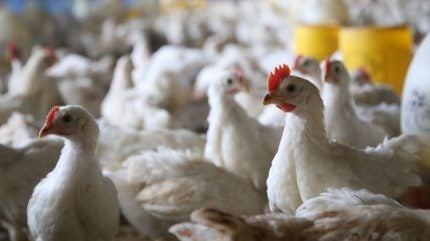
The US Department of Agriculture (USDA) has backtracked on proposals to introduce enforcement measures to cut the incidence of salmonella in poultry.
USDA announced yesterday (24 April), through its Food Safety and Inspection Service (FSIS) unit, that it needs “to further assess its approach for addressing salmonella illnesses associated with poultry products” following feedback.
In August, the FSIS proposed new product standards to address salmonella levels and serotypes in raw chicken carcasses, chicken parts, “comminuted chicken, and comminuted turkey products”. It also proposed all poultry slaughterhouses introduce procedures to prevent meat contamination by enteric pathogens.
The USDA added yesterday that it had “determined that additional consideration is needed in light of the feedback received during the public comment period,” which concluded on 17 January.
FSIS said it received 7,089 comments on the proposed framework from a broad variety of stakeholders, including “poultry and meat industry trade associations, small poultry producer and processor trade associations, large and small poultry processing establishments [and] consumer advocacy organisations”.
It said the standout debate that emerged from the comments centred on the FSIS’ “legal authority to propose the final product standards”.

US Tariffs are shifting - will you react or anticipate?
Don’t let policy changes catch you off guard. Stay proactive with real-time data and expert analysis.
By GlobalDataThe Center for Science in the Public Interest (CSPI) spoke against the decision to withdraw the proposal. The decision “will let poultry processors continue to ship raw chicken and turkey even after products test positive for high levels of the most dangerous strains of salmonella”, Sarah Sorscher, the advocacy body’s director of regulatory affairs, said in a statement.
“Salmonella is a leading cause of food poisoning. Every year, it sickens more than a million people, resulting in more than 26,000 hospitalisations, and about 420 deaths. One in six of these salmonella infections shows at least some antimicrobial resistance.”
She added: “Make no mistake: Shipping more salmonella to restaurants and grocery stores is certain to make Americans sicker.”
The National Chicken Council, an industry trade association, lauded the plan’s withdrawal.
It said the proposal “was legally unsound; relied on misinterpretations of the science; would have had no meaningful impact on public health; would have led to an extraordinary amount of food waste; and would have increased costs for producers and consumers”.
Ashley Peterson, the senior vice president of scientific and regulatory affairs at the Council, said in a statement: “We remain committed to further reducing salmonella and fully support food safety regulations and policies that are based on sound science, robust data, and are demonstrated to meaningfully impact public health.
“We look forward to working with the Agency on an approach to build on the industry’s tremendous progress in reducing salmonella on chicken products through policy that is based on sound science, is implementable, and will have a meaningful and measured impact on public health.”
Before the proposals were tabled last year, the USDA cited statistics from the Centers for Disease Control and Prevention, saying there are more than one million illnesses in the US each year caused by salmonella bacteria, with the highest incidence rate in food, particularly poultry.



